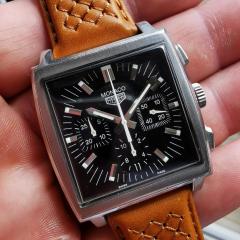Dreaded Fixed stud beat correction. Trial and error?
-
Recently Browsing
- No registered users viewing this page.
-
Topics
-
Posts
-
One of the problems with chronograph hands and whoever manufactured the watch would be that often times they are put on with considerable force. The problem with the amount of force they go on with is that often times when removed they disintegrate. So disintegrating hands unfortunately is quite common on a chronograph. With those lucky enough to have an account with were be authorized by whoever made the watch or the service center they would have a complete package of hands. so yes that does look like the brass tube of the hand that disintegrated.
-
The unfortunate problem of the three jar cleaning machine. At least I assume it's a three jar machine. Classically with three jar machine the first is a cleaner and the second to be a rinse of the same type. Cleaning is a interesting process and it's not exactly cleaning and rinsed the entire procedure is cleaning. The cleaner is supposed to have chemicals to put things in the solution and things to make things right and shiny. The rinse continues to put things in solution and reduces the concentration of things in the fluid on the plates. Ideally you should have two rinses not one and alcohol. If you look at the modern cleaning machines you find typically now they will have a minimum of four jars or whatever. Often times the last one will have alcohol because depending upon where you live the rinse itself may not evaporate. So you have a final rinse of alcohol just to rinse off the rinse. Then the only thing I've ever seen on baskets would be this quoted below from something Omega has. But they are assuming that you have genuine Elma baskets and not a machine made in India from unknown materials. Although a lot of people are using the baskets from India I just don't know enough about them. Personally I've see in the baskets for other machines especially the holder which would be as it's implied below nickel plated where the plating wears off and eventually the brass will be etched away from the chemicals in the cleaning product. One thing I didn't see you mention was how long in the each of the baths? Usually for the cleaning products that make things bright and shiny. Time-limited approximately 4 minutes works really well. The rinses of less of concern it depends upon how much the cleaning fluid is dissolved in it though. You can download the specifications the cleaning products I like they have recommended times the final alcohol rinse is supposed to be relatively short as any time we mention alcohol and watches people get excited over dissolving the shellac. But typically with isopropyl alcohol it takes a little while longer and I've even used alcohol which I know dissolves shellac but I was just using it to rinse off the rinse so it was never a problem.
-
By LittleWatchShop · Posted
I think i am done. I was working withe two pieces, one was 316 SS and the other 304 SS. The starting material for 304 was thinner, so I opted for finishing it. Since I only have images of one of these watches, I cannot know the exact dimensions. The owner is not critical...just wants a working solution. I think this is it. It was quite the challenge to turn the inside locking rim. An inside angle cut. Had to be damn close in order to have a snap fit. Frankly I think I just got lucky. Sometimes lucky is better than smart! The inside edge that interfaces with the crystal is an interference fit. This was on purpose in case my locking-edge cut was overshot...then the bezel and crystal would work together to stay put. Tens of hours working on this, and I learned a lot! -
By TimepieceTinkerer · Posted
I'm using: 2.5L Elma WF Pro – New Formula for the main cleaning 2.5L Elma Suprol Pro – New Formula for the first rinse Isopropanol Alcohol IPA 99.99% for the final rinse So far, all fresh fluids. I was also under the impression they shouldn’t cause rust, so I’m wondering if maybe the damage was already there and is just progressing now. Because my baskets came with the machine when I bought it pre-owned, I’m not sure if they’re original Elma or not. That’s exactly why I’m hesitant to buy a new set—I don’t want to end up with lower quality clones again if that’s what these are. -
By nickelsilver · Posted
It looks like the tube (pipe) for the hour counter hand pulled out of the hand and is still on the hour counter wheel. You can pry it off with small levers.
-






Recommended Posts